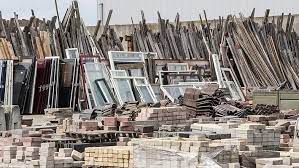When you throw a plastic bottle or your waste in a trash can, what does it become? Well, these days, it could be someone’s next construction material. Times are changing, and recycled materials in the construction industry are emerging. Let’s take a look at these materials and discover their benefits.

The most common recycled construction materials are:
- Aggregates
- Glass
- Plasterboard
- Plastics
- Recycled bricks
- Recycled timber
- Rubber
- Wood
Recycled aggregates. Its use has been an important step towards a more sustainable construction industry. They are developed from the reprocessing of certain materials, such as asphalt, crushed stone, gravel, recycled brick, recycled concrete, sand, and slags. They are usually used as a base for road construction and bridge foundations.
Glass. Glass has a diverse range of uses, and these include thermal insulation for prefabricated panels, cementitious glass, lightweight bricks, and other similar construction materials and flooring products.
Plastic. A range of plastics is primarily used in insulation, interior fittings, pipework, wall coverings & floorings, window frames, and more. Recycled plastics have been a low-cost alternative to other construction materials and become ideal building materials. They are durable, easy to mold, lightweight, and waterproof – which are obviously key qualities for construction materials. Recycled plastics are not yet widely used in the construction industry, but their potential is evidently there.
Recycled bricks, timber. Recycled bricks are known for their sturdiness; thus, they can be conveniently used in builds of all types. Recycled timber, on the other hand, is commonly used in landscaping and housing projects. It provides a natural and warm feel.
By using these recycled materials, more trees, water, and landfill spaces can be saved.
Benefits: Economic, Environmental
The benefits of recycled construction materials are so numerous, from protecting the environment to reducing the cost of disposal and transportation.
Using recycled construction and flooring products helps reduce the need for logging and quarrying – both of which can cause air and water pollution. It likewise saves energy, reduces greenhouse gas emissions, and saves landfill space.
Moreover, it also makes for one-of-a-kind residential and commercial structures. Plastics, for instance, have been used to build shelters as they are more affordable and stronger than concrete. And in Zurich, Switzerland, recycled concrete is being required to be used in the construction of public buildings. In 2012, the city built a school building with recycled concrete. Its main art museum has also been extended using 98% recycled concrete.
Where to Find Recycled Building Materials
Fortunately, there are several places to discover and get recycled building and construction materials. These include local contractors, teardowns, wood recycling stores, scratch and dent stores, salvage yards, recycling centers, local reuse centers, and online sites.
Constructing an entire building or home may not be feasible for everyone, but these people/places can surely help you get started.
Takeaway
The construction industry massively consumes natural resources and raw materials, and such create adverse environmental impacts. The good news is that with the availability of recycled construction materials, the industry can start to become sustainable and get green.
Indeed, the future of recycled building and construction materials looks bright and promising.




